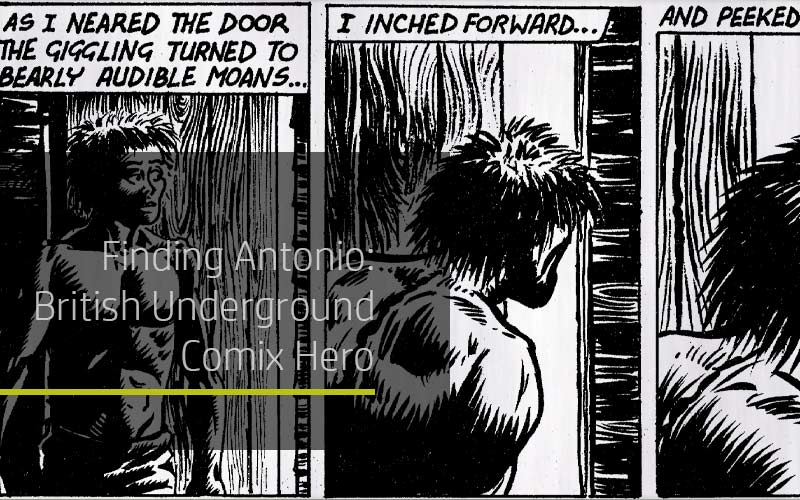
Finding Antonio
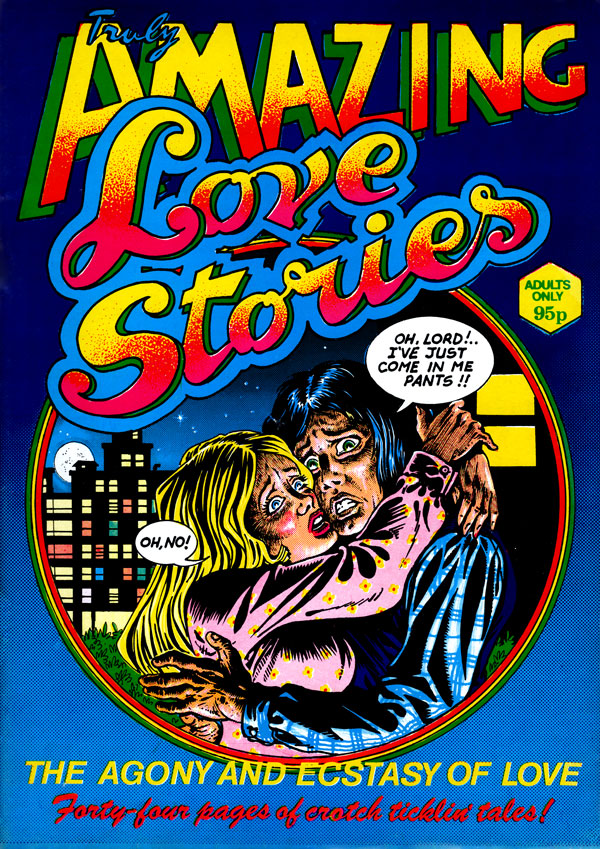
Underground comics are comics that exist outside of the mainstream. The phenomenon of the Undergrounds evolved out of a piece of legislation in 1954, which set out to redress the growing tide of crime comics and horror comics polluting the minds of American children. The introduction of this Comics Code meant that every comic book now had to carry a seal of approval in order to ensure news-stand distribution — as well as having to adhere to a sizeable set of guidelines outlining what could and couldn’t be shown, a central body scrutinised each comic prior to publication. Faced with such crippling confides, many comic publishers vanished overnight; others, who tried to adapt, produced work which was anaemic and surreal to the point that kids no longer bought them, and so died anyway. A decade-or-so later, a new generation of artists started to emerge who were freely inspired by the pre-Code comics they had read as children. Their comics, however, were independently produced, came in small print runs and didn’t rely on news-stand distribution. And while the social and political climate of the Sixties gave these Underground artists the ‘nerve’ to take on the subjects they did — sex, drugs, violence and religion — it was the Comics Code that gave them their agenda: ridicule the Code at every turn, wallow in and glorify every objection raised in that piece of strait-jacket legislation. It didn’t take long for Sex to become the dominant force in the Undergrounds. Underground comics were an outlet for a lot of diverse ideas, but to a bunch of young, hot-blooded, heterosexual males, “absolute freedom” — as Robert Crumb defined the Undergrounds — meant for many of the artists only one thing. Soon the comics fell into definable camps: those that devoted themselves to Sex and those that didn’t.
Like horror comics had filtered through in the Fifties, the first Undergrounds to appear in Britain consisted mainly of reprints of work by US artists (quite often, ripped-off without permission, under the proviso that it was all in the ‘spirit’ of the Underground). Alternative newspapers Oz and International Times (IT) both had comicbook imprints, pitting budding British talent alongside their more famous American counterparts. As the Seventies progressed, more British titles appeared that were dedicated to home-grown artists. A series of obscenity charges brought against ‘subversive’ British presses in the late-Sixties and early-Seventies, however, ensured that the British Undergrounds in general feared to be as overtly sexual as the American comics.
Oz had found itself in the dock faced with Obscenity charges over their ‘Schoolkids’ issue, as had the publishers of Nasty Tales when they reprinted some Crumb art in their debut number. One other publication to land in court in 1977 was Libertine, a self-proclaimed ‘new journal of authentic Victorian and period erotica,’ whose issue No 7 was tried and found not guilty of Obscenity. A comic strip entitled ‘Home on Leave’, was singled out by the prosecution. The artist was Antonio Ghura.
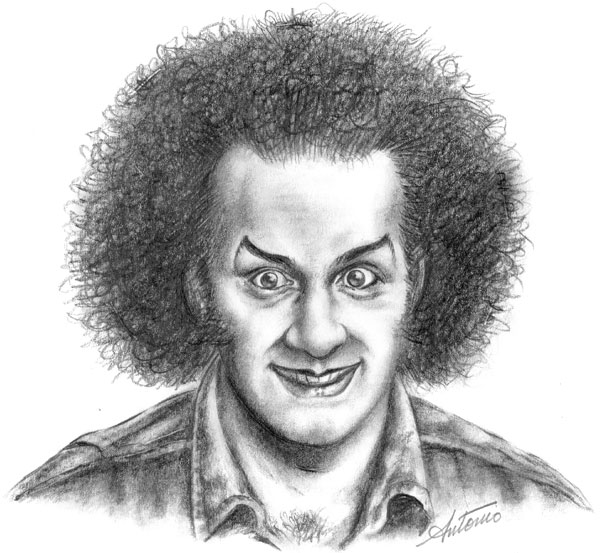
Whilst researching the article ‘Thrill To Stories of Graphic Lust’ that appeared in the book Critical Vision, I tried without success to contact Antonio Ghura. The article took an historical look at two decades of sex-orientated Underground comics from both sides of the Atlantic, but the idea was to bring the criminally neglected Ghura into the picture. As far as my research showed, no interview with Ghura had ever appeared in print, and no books or articles devoted to comics — Underground or otherwise — had ever bothered to acknowledged him. And yet, Ghura was responsible for some of the funniest, sexiest, most outrageous comics ever to make it into print — that he was printing and publishing them in Britain seemed only to make them all the more outrageous. His work was rarely dampened by the self-indulgent excesses associated with many of the Underground artists, but rather it followed a traditional comic book style: concise narratives, with an old-school comic book look. Ghura seemed to care not where he tread with his comics. His work was a fetid beacon in a marketplace slowly collapsing under its own sterility.
So what went wrong?
During the weeks I spent trying to track him down — asking distributors, possible acquaintances of his, even arriving at a telephone number that was no longer in service — a rather unsettling picture of Ghura began to emerge. He seemed to be a wild man. There were stories of him physically attacking people who he believed had wronged him, breaking into homes and brandishing knives. I already suspected that the phased, long-haired and dishevelled hippies that frequented his strips might have been caricatures of Ghura himself — now I became certain. (Particularly the one in ‘Love Conquers All!’, reeling in agony after some bird accidentally spills ice cold Coke on his naked balls at the Scunthorpe pop festival.) It wasn’t until some years after that article was published that I came into contact with Antonio.
Truly Amazing Love Stories is a pastiche of the Romance comics so popular in Fifties America.
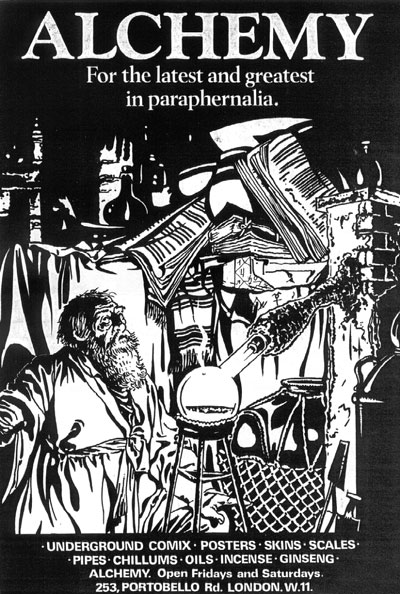
Outside of the occasional strip, spot illustration, and ads for head shops contributed to Home Grown, Zig Zag and the like, Ghura’s main body of work is to be found in several comic titles which he single-handedly wrote and illustrated. The first of these was Bogey, published in 1975, which featured several mock advertisements, a lengthy drug strip called ‘The Peyote Connection’, and an incest-themed strip titled ‘Fatherly Love’. The whole thing was a dry run for Ghura’s next project, the comic he’s possibly best known for: Truly Amazing Love Stories. Published in 1977, Truly Amazing Love Stories is a pastiche of the Romance comics so popular in Fifties America. ‘Forty-four pages of crotch ticklin’ tales!’ the cover boasted. Indeed, the very funny hardcore strips — which have themes such as lesbianism, homosexuality, the clap, and bestiality — combined with a dodgy Agony Aunt and fake ads for cannabis and police recruitment, made Truly Amazing Love Stories No 1 a success. The print run of 3,000 copies soon sold out, but it wasn’t until 1983, over five years later, that Ghura got around to producing the second edition. By this time, however, Ghura’s main outlets for distribution were closed to him, and, left to handle the comic himself, Truly Amazing Love Stories No 2 did very badly. When I spoke with Ghura in mid-1998, lack of distribution ensured that only 200 copies of the 3,000 print run had thus far been sold. (Which makes it particularly fortuitous that I should have picked up a copy when it came out in the early-Eighties.)
If the first issue was a Bronx Cheer in the face of British censorship laws, Truly Amazing Love Stories No 2 succeeded in kicking them out of the ball park altogether. The format was the same, but with better quality paper stock, more striking artwork (Ghura said that he drew issue No 1 “very quickly”), and Madge Poops, the Agony Aunt, being replaced by Babs Cartfart. This time the stories were more developed, and appeared to go less for out-and-out laughs and more for vivid depictions of the sex act. Themes included a sex-change romance, incest, and used-tampon gags. More than anything else, the tone of the issue was influenced by a strip he titled ‘I Loved A Sex Fiend!’ which played out a rape scene over five excruciating pages. If that wasn’t enough, the rapist was one “Paul Rutcliffe”, a dead ringer for Peter Sutcliffe, the Yorkshire Ripper.
Raw Purple and The Laid-Back Adventures of Suzie and Jonnie, published in 1977 and 1981, respectively, switched sex for stories of pot, LSD and hippie drug culture. The former is essentially Truly Amazing Love Stories in a different jacket, but Suzie and Jonnie is more akin to Gilbert Shelton’s early The Fabulous Furry Freak Brothers — very intricate, self-contained page-long stories that contribute to a larger picture. Artistically, it contains some of Ghura’s best work.
Ghura’s only other comics are the digest-sized Hot Nads and Bogey No 2. Hot Nads, published in 1979 and billed as the ‘first & last issue’, is a rather lacklustre take on Robert Crumb’s Snatch Comics incorporating, for the most part, TV personalities and politicians of the day in a series of outrageous sex cartoons. Bogey No 2, published in 1984, is wholly more satisfying with some very crisp artwork, and a reprint of the controversial ‘Home On Leave’ strip from Libertine. [NOTE: At the time of writing, the author had not seen a copy of Bogey No 1.]
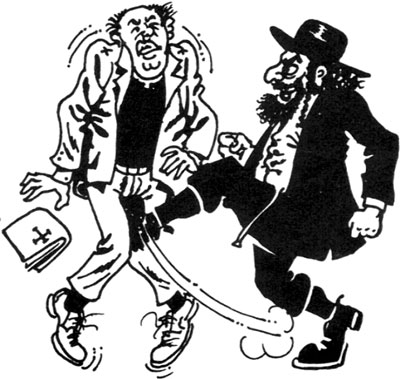 My eventual meeting with Antonio came about like this: At the beginning of 1998, I got a phone call from Roger Sabin, author of the book Comics, Comix & Graphic Novels. Ghura had discovered that Roger’s book contained a passing mention of him and, as luck would have it, had written to the author via the publisher in order to try and blag a copy. Roger was aware that I had been trying to reach Ghura some years earlier, and contacted me, furnishing me with Ghura’s London address and a telephone number. That day, I mailed Ghura a copy of the Critical Vision book containing my ‘Thrill To Stories of Graphic Lust!’ article. A couple of days later, I gave him a call.
My eventual meeting with Antonio came about like this: At the beginning of 1998, I got a phone call from Roger Sabin, author of the book Comics, Comix & Graphic Novels. Ghura had discovered that Roger’s book contained a passing mention of him and, as luck would have it, had written to the author via the publisher in order to try and blag a copy. Roger was aware that I had been trying to reach Ghura some years earlier, and contacted me, furnishing me with Ghura’s London address and a telephone number. That day, I mailed Ghura a copy of the Critical Vision book containing my ‘Thrill To Stories of Graphic Lust!’ article. A couple of days later, I gave him a call.
Ghura seemed happy to do an interview, so I arranged to travel down to London the following week and met with him in a pub off Tottenham Court Road. [NOTE: The Tottenham, opposite Tottenham Court Road tube station; the pub still exists but is now called something else.] I was about to untangle another thread of my teenage youth, with the guy who so fried my brain with the first issue of Truly Amazing Love Stories back in the Seventies. There was no doubt about it — I was approaching the mysterious Ghura with reserved awe!
Ghura had with him a big holdall stuffed with his comics.
Ghura had with him a big holdall stuffed with his comics, which he intended to tout around London’s comic shops after our interview. It had been some time since he had last bothered trying to sell them, but he had heard of a new place on or near Shaftsbury Avenue which might be interested.
Ghura was older than I anticipated, but then my mind was locked on that image of the crazed hippie at the Scunthorpe pop festival in Truly Amazing Love Stories No 1.
It was fortuitous that I managed to make contact when I did, because Ghura was about to leave Britain for good at the end of the year for Italy. He was disillusioned about the opportunities for artists in Britain, having slogged at it for most of his life for virtually no return and no recognition. Comics, it transpired, were only a part of his artistic talents. He told me he hadn’t drawn a comic strip for at least ten years, and it had been twice that since he last had a strip published. Latterly, he had been doing portraitures and selling paintings to tourists.
Ghura spoke in an accent that was equal measures Italian and cockney. He gave to me several comics of his that I told him I was missing, as well as some I already had, and photocopies of the completed artwork for his never-published third issue of Truly Amazing Love Stories. He seemed nervous and thrilled that he was being interviewed. Certain parts of the conversation, however, triggered memories he obviously would rather have forgotten, whereupon a black cloud crept over him and his mood changed. Indeed, it got so I felt bad about going down some of these avenues, but I felt I had to it nonetheless. And there it was, only fleeting perhaps — Scunthorpe pop festival behind those eyes.
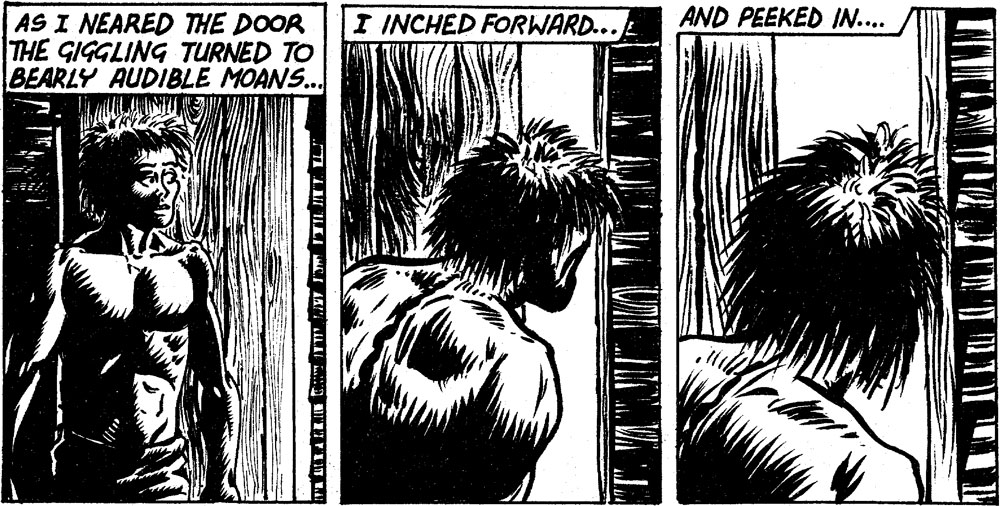
HEADPRESS: You had a strip called ‘Home on Leave’ published in Libertine No 7, an issue which landed in court charged with Obscenity. Can you tell me a bit about that?
ANTONIO GHURA: What happened there was I met a couple of the guys who worked for Libertine, Colin [Johnson] and Arabella [Melville]. They wanted an artist to draw a strip or do illustrations. I think that was the first strip I did for Libertine, and they got busted! Mary Whitehouse complained and they got taken to court, and lost about £10,000. Of course, the police confiscated all the magazines in the meantime. That finished them off — so, I’m to blame!
HEADPRESS: How close were you to that? Did you have to go to court?
ANTONIO GHURA: No. Colin and Arabella asked me to attend, but I said leave me out of it. I had my room full of Truly Amazing Love Stories No 1 at the time, using them as furniture. I didn’t want the Boys in Blue to find out.
HEADPRESS: Libertine was acquitted in the end though, wasn’t it?
ANTONIO GHURA: Yeah, but they had to pay costs. And all the books they had were kept back so they couldn’t sell them.
HEADPRESS: There’s a story I’ve heard, that the centre pages of that issue of Libertine featured a nude pin-up of Arabella, which the prosecution intended to use in the case. But when it was called as evidence, it turned out somebody had swiped the pin-up from the court’s copy! The police themselves were suspected!
ANTONIO GHURA: I haven’t heard that one. I can’t remember the centre-spread, but I haven’t seen a copy of that in years. Arabella used to spread it about a bit, though [laughs]!
HEADPRESS: That trouble obviously didn’t compromise your work any.
ANTONIO GHURA: No. I carried on the same. But Libertine did stop taking some of my strips which they considered too risqué, for a while. When they were busted, it took a year-or-so before the case came to court. So in that time they were still publishing the magazine and I kept sending them strips.
HEADPRESS: Can you tell me a little about your background? Where you were born?
ANTONIO GHURA: I was born on the 10th July, 1949 in Bari, Italy. My father brought the family over to England in 1960, after his business in Bari folded. We moved around quite a lot, and in the early Sixties we lived in Wimbledon, Stepney and Walthamstow. Stepney at that time was a Jewish area, full of Rabbis sitting outside their shops, plucking chickens. When the wind blew, the place looked like it was snowing —white chicken feathers all over the place, pavements covered in them.
I came across all these American Undergrounds in Compendium Bookshop. So I started to draw a few myself.
HEADPRESS: How did you get started in comics?
ANTONIO GHURA: I left school at sixteen in 1966. I was painting in oils, and selling my paintings in Hyde Park, and doing little drawings and stuff like that. Then, in about 1969 I returned to London after a two-month holiday in Italy, and I came across all these American Undergrounds in Compendium Bookshop. So I started to draw a few myself. I couldn’t stay in Italy any longer due to the fact that I had become a British citizen in order to avoid my Military Service — I didn’t want to spend eighteen months learning how to get shot!
HEADPRESS: What comics had you seen prior to the Undergrounds?
ANTONIO GHURA: I remember reading comics as a child in Italy, stuff like Topolino and Il Monello. In the UK, I read Superman and Batman, but much preferred the ghost and horror comics. At around the age of twelve or thirteen, I began to read Mad and The Executive Comic Book, which featured ‘Goodman Beaver’ by [Bill] Elder and [Harvey] Kurtzman. That really opened my eyes and took me away from all that superhero stuff. In 1971/72, I came across an English edition of Fritz the Cat. It turned out to be a pirated copy of the American edition, but I didn’t know that at the time. There was an ad asking for artists and cartoonists to send artwork in. Which I did, and received a reply from a guy called John Muir, who said how much he liked my art. A while later I received a phonecall inviting me to a get-together over at Phillimore Place in Kensington. That’s where I met Jonathan Holland-Gems and other cartoonists.
HEADPRESS: Jonathan Holland-Gems?
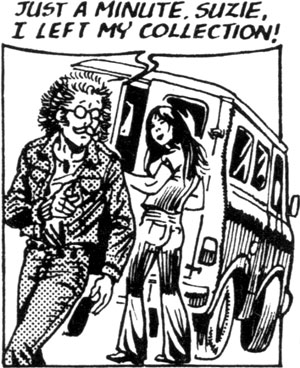
ANTONIO GHURA: Yes. He’s the son of Pamela Gems, the famous playwright. He did the magazine Student with Richard Branson in around 1966/67. I saw him on TV one time in 1978, on The David Essex Show; he had formed a band called Johnny and the Gemstones. I thought to myself, where have I seen that face before? Then it twigged! Well, they called me over and had a little dinner party, and said “OK, can you draw some stuff for this comic we’re doing called Its All Lies [sic].” And the first issue that Jonathan Gems published was printed by John Muir — yellow cover, you couldn’t miss it!
Gems said to the assembled cartoonists that he would pay us after issue No 6. I understood this to mean that after No 6 he would pay us for all our work to date, but what he meant was that he would pay us from No 7 upwards. Issues 1 to 6 we would work for free. But, of course, there was no issue No 7! Still, after six months-or-so working on Its All Lies I said to Gems “Well, how about paying me?!” and Jonathan Gems — dead rich bloke, his dad’s dead rich – wanted to pay me with food! No money! He opens his big fridge freezer and said “Take all the food you want!”
HEADPRESS: So you never got paid?
ANTONIO GHURA: No. I wasn’t that hungry, either.
HEADPRESS: What happened to his and Branson’s Student magazine?
ANTONIO GHURA: That had folded by then. It disappeared before I met Jonathan Gems. Richard Branson already had a shop in Nottinghill Gate selling records, while Gems went into comics. He also helped me to get an illustration in Creem magazine. But I actually didn’t get to meet John Muir until a little later. I was on my way to meet a guy called Michael Feldman, in Nottinghill Gate, who was a friend of Gems, but had a slight falling out with him. On the way there, this stranger shouted “Hey!” from across the street. He seemed to know me. I had my art folder with me. He stopped me, introduced himself. I showed him my art work. He took my art work, and that was it. I never got to meet Michael Feldman that day, but I met John Muir in the street. He had a head full of hair, pink bell bottoms and wore nine-inch platform shoes.
HEADPRESS: He took your art work?
ANTONIO GHURA: Yeah, but he didn’t do anything with it. He kept it for a few months, then returned it. [NOTE: When I spoke with Ghura a couple of weeks later to clarify a few points in the interview, he asked me if I had Muir’s address as he wanted to get some of his artwork back for his portfolio. Or, on failing that, some of the music books Muir published as Babylon Books, which contained Ghura’s art — notably those on Abba, Genesis, David Bowie, Queen, etc.] Then some months later — maybe a year — he telephoned me and said he wanted a cover for a comicbook he was producing, which he wanted to call Beaver but later changed to Hot Gravy. So I did a cover in b&w, and mailed it to him. Some months after that, I met Muir at Charing Cross station, and he gave me four or five copies of Hot Gravy with this really horrible colour he had added to the cover I’d drawn. Only later did I find that it was a rip off title. I was a little naïve then. Because he had stuff in there by Robert Crumb, I thought they were regular guys and that I was in the big league now! Muir was the one who put me in touch with the Libertine guys.
HEADPRESS: Was there an unwritten rule in the Sixties and Seventies that said you could reproduce Underground work, to a degree…?
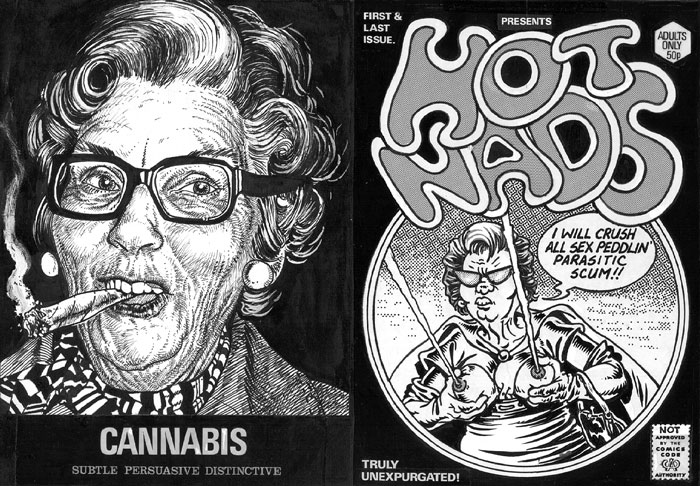
ANTONIO GHURA: I think Robert Crumb said you can use work from Snatch Comics and print it where you like. But not that other stuff… This was back in 1972/73, thereabouts, and I was still finding my way around.
HEADPRESS: Isn’t Michael Feldman credited as a writer on some of your earlier work?
Robert Crumb said you can use work from Snatch Comics and print it where you like.
ANTONIO GHURA: He only ever contributed to one story. That was in Bogey No 1. He wrote this story where a bloke is screwing this rubber doll. That’s his. He never contributed anything else… [thinks for a moment] apart from in Bogey No 2, where he gave me a story in 1973/74 which I later found was ripped off from a Cheech & Chong record, about the Pope wanting a woman that’s deaf, dumb and blind [for sex] so that she can’t say anything afterwards. I told Feldman it was copyright, but he told me it was okay. So I did it. He read the story to me over the phone — and I forgot about it until I did Bogey No 2. I did ask Feldman if he wanted to work with me on comics together, and we tried to get a weekly strip going in Time Out, but nothing came of it. Feldman said that comics don’t sell, don’t get involved with them. In fact, Felix Dennis told me that as well. “Forget it,” he said, “there’s no money in it.”
HEADPRESS: Did you have any dealings with Oz or Cozmic Comics, at all?
ANTONIO GHURA: Felix Dennis phoned me up once and said he wanted my drawings to appear in ‘Spike’, the news page in Oz. Then two or three weeks later he phoned back and said forget it, Oz has folded. Something about John Lennon not giving them a cheque that was supposed to be going to pay for Oz to be published. [NOTE: The proceeds from Lennon’s ‘God Save Oz’ single, perhaps?] Oz folded and Felix Dennis got involved in all that kung fu stuff — Kung Fu Monthly — and made his millions.
HEADPRESS: What else did you contribute to?
ANTONIO GHURA: During that time? Zig Zag — I did a cover for them and a cartoon strip about The Runaways, the all-girl band. I did a bunch of eight-page war comic strips for Fleetway, which was around about the same time I did Hot Gravy. I had no interest in the war stories at all, and just did it for the money — which was £8 a page. Fleetway wanted someone to draw Italian and British soldiers fighting, with all the usual jingo-ism they use in those comics, but I made the Italian soldiers handsome and the British soldiers all pimply and ugly! I’ve no idea what happened to those strips, whether they got published or not — or even what they were called. And I never got the money for them. I did strips, with Feldman, for Info, the French Chamber of Commerce publication. But we made fun of the Director, portraying him as a waiter, and that was the end of it! He kicked us out!
I think I also did something for Science Fiction Monthly… but I can’t remember! My memory’s not what it was! I was taking… you know… [laughs]
HEADPRESS: What influenced Truly Amazing Love Stories?
ANTONIO GHURA: American romance comics. They’re all kissing and lovey-dovey, not the real thing. I thought I’d make it more adult; more of what it’s all about. Take it away from the imagination and put it on paper. See how the girls like it. That was the idea: see how the girls like it!
HEADPRESS: And did they like it?
ANTONIO GHURA: I don’t know. None of them said anything! [laughs]
HEADPRESS: Truly Amazing Love Stories No 2 is perhaps the most over-the-top comic I think I’ve ever seen. You’ve got a story with a transsexual twist, a bestiality strip and, of course, the Yorkshire Ripper strip.
I was trying to go for everything: lesbianism, homosexuality, incest… you name it, I wanted to go for it.
ANTONIO GHURA: I was trying to go for everything: lesbianism, homosexuality, incest… you name it, I wanted to go for it.
HEADPRESS: Were you never worried about getting in trouble with the law with these comics?
ANTONIO GHURA: I didn’t think of it. I sold it to guys who could sell it. Some would sell it openly; most shops would sell it under the counter. Dark They Were And Golden Eyed sold Bogey No 1 and Amazing Love Stories quite openly. No problem… until they got busted once. But a week later they were selling it again. That was in St Anne’s Court, the shop they opened after Berwick Street. But they didn’t blame me, and kept my name out of it. That was nice of them. The police shut down the shop for a day, and they lost a day’s takings, but they just told the police that some guy — who they didn’t know — had dropped all these comics off. They got done twice that I know of. Once in 1978 and in 1981.
HEADPRESS: Tell us a little about ‘I Loved A Sex Fiend!’, the Yorkshire Ripper strip.
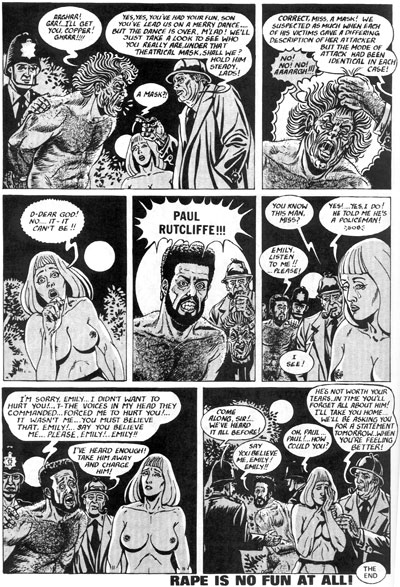
ANTONIO GHURA: The rape one? I wanted to be outrageous. Everybody does action comics, fighting and battling and killing each other, and pontificating about this and that, while at the same time punching each other in the face — and I thought, well, give them that. Most people didn’t like it, and said, “Oh, you’ve gone too far there. What you’re doing is sexist fun, and then you put this in.” Looking back at it, I thought maybe I should have left it out. I didn’t want to do things that’d leave a bad feeling.
HEADPRESS: It’s odd because you have this graphic, prurient rape strip and at the end you say ‘rape’s no fun at all’.
ANTONIO GHURA: Yeah, yeah, because I felt guilty about it. It was just anger inside me that came out on the paper.
HEADPRESS: Did you ever get any kind of critical reaction at all?
ANTONIO GHURA: No. I went to a comics convention with Hunt Emerson, near Shaftsbury Avenue, one time back in 76 or 77. And somebody asked me for my autograph. But other than that, no reaction from anybody ever. I remember speaking to Hunt Emerson and saying, you’re an Underground artist, why don’t you do something a little outrageous? Drugs, sex, violence? When somebody gets shot, all his brains spill out. Why don’t you do it, show how shocking it is, how real and nasty it is? “Oh I don’t wanna do anything like that,” he says, “I don’t wanna shock my mum.”
HEADPRESS: You’re completely ignored in America — well, you’re ignored here, too…
ANTONIO GHURA: Could be because people think I ripped them off with Hot Gravy. When Mal Burns went around saying I’d published Hot Gravy…
HEADPRESS: What was that about?
ANTONIO GHURA: In 1977 I met Mal Burns in a pub, and he asked me who had done Hot Gravy. I replied, “I did!”… meaning the cover. But Burns, who was compiling his Comix Index [Mal Burns Comix Index: The Directory of Alternative British Graphic Magazines: 1966-1977, pub: 1978], then spread the totally false allegation that I was responsible for it all. Not so. I have not and will not rip off another Underground artist’s work. Burns also distributed copies of Amazing Love Stories No 1 and Raw Purple in 1978. When it came time to pay up, he said to me, “I don’t have the money, so sue me.” But with gentle persuasion he paid up… eventually… after a few bounced cheques.
HEADPRESS: How long would it take for you to do a full comic.
ANTONIO GHURA: Ages. This one [Truly Amazing Love Stories No 3] took about six months. Forty-eight pages.
HEADPRESS: Is that typical?
ANTONIO GHURA: Yes. Six months, thereabouts.
HEADPRESS: It’s a lot of work for no return.
ANTONIO GHURA: Yes. And I always tried to make my work look interesting and ‘sophisticated’, using Letratone. So it cost me a bit to do, too.
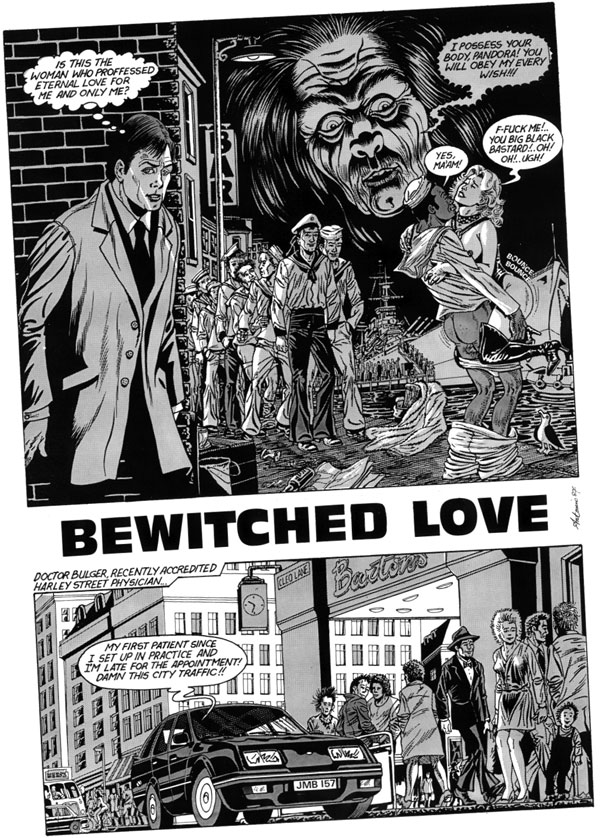
HEADPRESS: Why did you change the physical size of your comics from A4 down to A5?
I always tried to make my work look interesting and ‘sophisticated’, using Letratone.
ANTONIO GHURA: For Hot Nads, I tried to copy Robert Crumb’s Snatch Comics, but for Bogey No 2, I just ran out of cash.
HEADPRESS: I’ve always wondered: did you ever draw yourself as a character in your comics?
ANTONIO GHURA: The inside front cover of Bogey No 2 is supposed to be me in my ‘studio’. [NOTE: It’s a picture of a naked woman sitting on an easel, with an artist nuzzling his face between her thighs.]
HEADPRESS: How about Suzie and Jonnie? You yourself went to Morocco in 1976.
ANTONIO GHURA: Some parts of that are based on my trip over there. I had a Volkswagen 1300 at the time, and on my way home the Spanish customs took it to pieces completely because they found a big handful of grass in the glove compartment. The car wasn’t the same after that. But they did let me go. They took my stuff, though, and smoked it all themselves. Next day, their eyes were all red and bloodshot. I thought that Suzie and Jonnie would sell. I packed a lot into it, and made it value for money, not too much sex in it. And it didn’t.
HEADPRESS: When did you actually stop doing comics?
ANTONIO GHURA: I stopped doing comics with Amazing Love Stories No 2. Then, in 1987, I thought I’ll give it another try and did Amazing Love Stories No 3. I had the idea of selling it to Torrid, a sex magazine published by Goldstar. I thought maybe they’d be interested in it. They weren’t.
HEADPRESS: You mentioned earlier you are going to return to Italy.
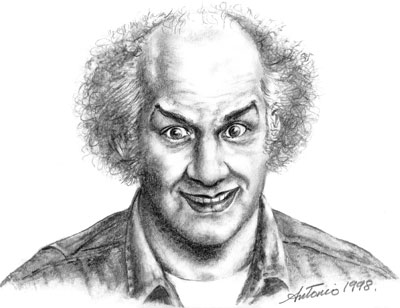
ANTONIO GHURA: Yes. I’m going back in September or October of this year [1998] and not coming back. I’ve travelled to Italy a few times, doing portraits and selling them to tourists. I’ve tried painting and drawing here in England, and people just don’t want to know. I’ve tried getting work at design companies and they go, “We’ll let you know”. After seeing my portfolio, they think that whatever work they give me to do, I’ll start drawing sex stuff! “Who’s that old bloke?” was one comment I recently overheard at an interview, coming from the same bloke who then proceeded to interview me!
HEADPRESS: You’re still working in art then?
ANTONIO GHURA: Yes, at the moment mainly doing portraiture from photographs. I put ads in papers and people send me photographs of their ‘cute’ kids, you know! They come and tell you the story of how their little boy got run over and would like you to paint his picture from this photograph. And I charge them £300 for it and feel bad. But that’s what I’ve been doing — painting. I left school at sixteen and started painting. That’s what I like to do. I got into comics because I used to do oil paintings and they’d smell a lot. “What can I do that doesn’t smell?” I thought. Comics! That’s easy — just paper and ink, that’s all you need. Most of my painting is watercolours nowadays. And, of course, in Italy, I shall be surrounded by art… sculpture, paintings, and good food, good football, and lovely ladies. A nice way to spend the autumn of my life.
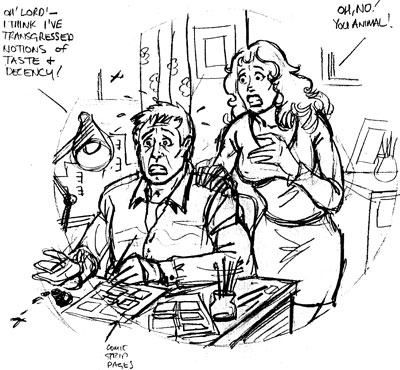
When the interview was over, not for a moment did I hesitate to ask Antonio to sign the copies of the comics he had given to me.
I had time to kill before my train back to Manchester. After mooching aimlessly for an hour, I decided to go for a coffee and a sandwich at a cheap Italian place around the corner. I bumped into Antonio, lugging his big, heavy holdall, unable to find the new comic shop that was situated in or around Shaftsbury Avenue. I felt it was ridiculous that he should be having to drag his own twenty-year-old comics around shops at his age and with his talent, given that under different circumstances (perhaps in America) he would be nothing short of a cult phenomenon. It transpired he had given up searching for the shop and was now headed for the same café as I, so we chatted a while longer. He asked whether I was worried about the nature and content of Headpress getting me into trouble. “You know the answer to that,” I replied.
For his return to Italy, Antonio had bought a small van. He was headed for no place in particular, but intended first to travel around Rome, sleeping in the back of his van, before finding a place in which to settle. Before leaving Britain, however, during the van’s MOT, Antonio managed to get a parking ticket and, unable to pay the growing fine, lost the vehicle. It didn’t deter him. The next I heard from Antonio was a postcard from Rome dated late-October 1998; no return address, but the promise that he would write again soon when things are “more settled”.
[NOTE: I commissioned some original art from Antonio, and he came up with the cover of Headpress 18, where the above article and interview originally appeared (in a different version). Antonio sent me a Christmas card each year following our interview. He did leave for Italy but returned to Britain some years later. I was fortunate to meet him one more time before his passing in 2011.]
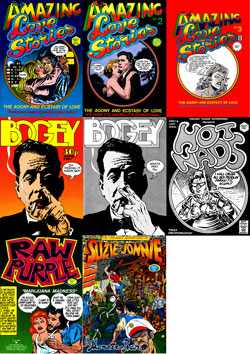 GRAB THEM NOW!
GRAB THEM NOW!
Antonio Ghura’s entire run of Self-Published Underground Comix titles are available for download here.
David Kerekes
Like this article?
Related Posts
Comments
Copyright © Headpress



One Response
Great interview! Antonio comes across as a wonderful character and I was all psyched up to meet him someday, so was very saddened to learn of his passing. However, it is good to know that you met him again after his return from Italy. I had not seen Bogey #2 nor, of course, Amazing Love Stories #3 before reading this, but I was impressed by Antonio’s uninhibited comix, which are more S. Clay Wilson than Crumb to my mind. My experiences with Mal Burns were somewhat similar to those of Antonio, who was more fortunate than I in the outcome.